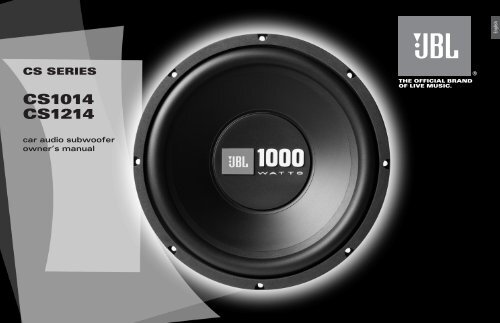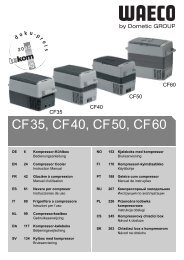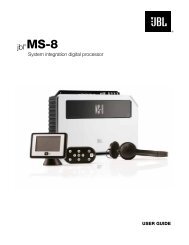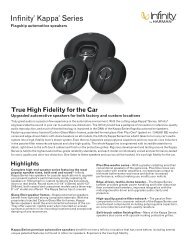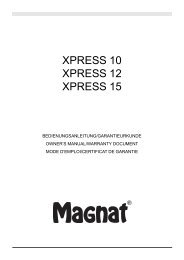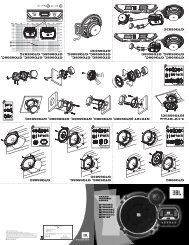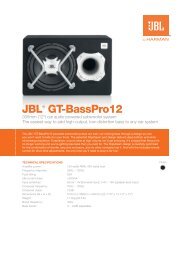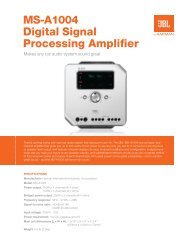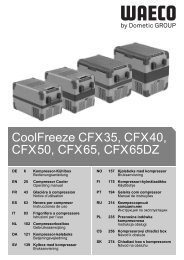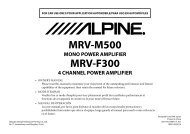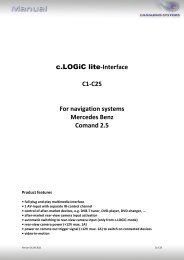English - JBL
English - JBL
English - JBL
Create successful ePaper yourself
Turn your PDF publications into a flip-book with our unique Google optimized e-Paper software.
<strong>English</strong><br />
CS SERIES<br />
CS1014<br />
CS1214<br />
®<br />
THE OFFICIAL BRAND<br />
OF LIVE MUSIC.<br />
car audio subwoofer<br />
owner’s manual
CHOOSING AN ENCLOSURE<br />
THANK YOU for purchasing<br />
a <strong>JBL</strong> ® CS Series subwoofer.<br />
Subwoofer installation requires<br />
woodworking skills and some<br />
experience in disassembling and<br />
reassembling automotive interiors.<br />
If you lack the tools or necessary<br />
skills, have your subwoofer installed<br />
by an authorized <strong>JBL</strong> dealer.<br />
WARNING: Playing loud music<br />
in an automobile can permanently<br />
damage your hearing as well as<br />
hinder your ability to hear traffic.<br />
Listening at low levels while driving<br />
is recommended. <strong>JBL</strong>, Inc., accepts<br />
no liability for hearing loss, bodily<br />
injury or property damage resulting<br />
from use or misuse of this product.<br />
CS Series subwoofers are optimized<br />
to perform best in small, sealed,<br />
vented and prefabricated bandpass<br />
enclosures. While infinitebaffle<br />
mounting of CS Series subs<br />
is possible, power handling will<br />
be greatly compromised because<br />
there’s no enclosed volume of<br />
air to prevent the speaker’s cone<br />
from moving past its limit. For this<br />
reason, infinite-baffle mounting is<br />
not recommended for CS Series<br />
subwoofers.<br />
You should choose the enclosure<br />
you will use based on the type<br />
of music you listen to, how much<br />
amplifier power you will use for the<br />
subwoofer and how much space<br />
inside the vehicle you can devote<br />
to a subwoofer enclosure.<br />
Because a sealed enclosure<br />
provides the most control over<br />
the woofer’s movement, a woofer<br />
mounted in a sealed enclosure will<br />
handle more power than a woofer<br />
mounted in another enclosure type.<br />
Sealed enclosures provide moreaccurate<br />
sonic reproduction than<br />
other enclosure types when<br />
mounted inside a vehicle, so they<br />
are well suited to all types of music.<br />
Sealed-enclosure construction is<br />
straightforward, and there are many<br />
prefabricated sealed enclosures<br />
available. An optimum sealed<br />
enclosure is always smaller than<br />
other types of enclosures optimized<br />
for a particular speaker, so they<br />
require the smallest amount of<br />
space inside the vehicle.<br />
Vented enclosures provide better<br />
efficiency in the 40Hz – 50Hz range,<br />
but this efficiency comes at the<br />
expense of sound in the lowest<br />
octave (below 40Hz) and at the<br />
expense of some control and power<br />
handling at the lowest frequencies.<br />
If you are using a small amplifier,<br />
a vented box will provide more<br />
perceived bass output from less<br />
power. Vented enclosures are also<br />
well suited to a variety of music<br />
types. Because vented enclosures<br />
require the volume of the enclosure<br />
and the size of the port to have<br />
a specific relationship with the<br />
characteristics of the woofer, the<br />
enclosure must be built exactly to<br />
the specifications provided. While<br />
there are some prefabricated<br />
vented boxes available, matching<br />
a prefabricated box to a particular<br />
woofer is difficult. If you wish to<br />
use a vented enclosure, it is strongly<br />
recommended that you have your<br />
authorized <strong>JBL</strong> dealer build it or<br />
verify that your design is correct<br />
if you wish to build it yourself. An<br />
optimum vented enclosure is always<br />
larger than the optimum sealed box<br />
for the same woofer and will require<br />
more space inside the vehicle.<br />
Band-pass enclosures often<br />
provide the most output available<br />
from any amplifier and subwoofer<br />
combination, at the expense of sonic<br />
accuracy.<br />
If sheer SPL (sound-pressure level)<br />
is what you desire most, choose a<br />
band-pass enclosure. Band-pass<br />
enclosure design is very tricky, and<br />
the aid of a computer and enclosure<br />
design software is necessary. If you<br />
are an experienced installer or have<br />
some woodworking experience,<br />
you may wish to build the bandpass<br />
enclosure described in the<br />
enclosure design sheet included<br />
with this woofer. Fortunately, there<br />
are many prefabricated band-pass<br />
boxes<br />
available, and they are all optimized<br />
to extract the most output possible<br />
from any woofer. Band-pass<br />
enclosures can be quite large and<br />
may require a lot of space inside<br />
your vehicle.<br />
2
CONNECTING YOUR SUBWOOFER TO YOUR AMPLIFIER<br />
<strong>English</strong><br />
Your CS Series subwoofer has a<br />
single 4-ohm voice coil. Be sure to<br />
consider your amplifier’s optimum<br />
load when designing a subwoofer<br />
system. Many bridgeable 2-channel<br />
amplifiers are optimized to drive<br />
a single 4-ohm woofer in bridged<br />
mode. If you will use multiple<br />
woofers, be sure to configure them<br />
to extract all the power available<br />
from your amplifier. When designing<br />
a subwoofer system, consider the<br />
following rules:<br />
1. Do not mix different subwoofers<br />
or enclosure types in the same<br />
system. Subwoofers being used in<br />
the same enclosure or powered<br />
by the same amplifier should<br />
be identical models. Mismatched<br />
woofers and enclosures<br />
can result in poor system<br />
performance.<br />
2. Most amplifiers deliver exactly<br />
the same amount of power<br />
bridged into a 4-ohm load<br />
as they do driving a 2-ohm<br />
stereo load.<br />
3. If you are designing a multiplewoofer<br />
system, be sure to<br />
configure the woofers so that they<br />
each receive the same amount of<br />
power from the amplifier. Never<br />
connect two identical woofers in<br />
series and then connect that pair<br />
to another woofer in parallel. If<br />
your system will include an odd<br />
number of woofers, be sure to<br />
connect all the woofers in either<br />
series or parallel, according to<br />
the rules that follow, in order to<br />
maximize the power available<br />
from your amplifier:<br />
a. The total system impedance<br />
of voice coils (or woofers) in<br />
series can be calculated using the<br />
formula:<br />
Impedance = w 1<br />
+ w 2<br />
+ w 3<br />
...<br />
b. The total system impedance<br />
of woofers in parallel can be<br />
calculated using the formula:<br />
Impedance =<br />
1<br />
1<br />
w<br />
+ 1<br />
1<br />
w 2<br />
+ 1 ...<br />
w 3<br />
where w is the nominal<br />
impedance of the woofer.<br />
The diagrams at right show series<br />
and parallel speaker connections.<br />
Figure 1. Connecting two woofers<br />
in series to the amplifier (8 ohms)<br />
Red<br />
Positive<br />
To Amp<br />
Positive<br />
Black<br />
Negative<br />
Red<br />
Positive<br />
Black<br />
Negative<br />
To Amp<br />
Negative<br />
Figure 2. Connecting two woofers in<br />
parallel to the amplifier (2 ohms)<br />
Red<br />
Positive<br />
Red<br />
Positive<br />
Black<br />
Negative<br />
Black<br />
Negative<br />
To Amp<br />
Positive<br />
To Amp<br />
Negative<br />
3
SPECIFICATIONS<br />
CS1014<br />
CS1214<br />
10” (250mm) Subwoofer 12” (300mm) Subwoofer<br />
Power Handling, RMS 125W 250W<br />
Power Handling, Peak 500W 1000W<br />
Sensitivity (2.83V/1m) 90dB 90dB<br />
Frequency Response 45Hz – 200Hz 35Hz – 200Hz<br />
Impedance 4 Ohms 4 Ohms<br />
Mounting Depth 4-9/16” (115mm) 6-1/16” (153mm)<br />
Cutout Diameter 9” (228mm) 11” (279mm)<br />
Overall Diameter 10-1/16” (255mm) 12-1/4” (311mm)<br />
GENERAL CARE<br />
The loudspeaker grille may be cleaned with a damp cloth. Do not use any cleaners or solvents on the grille or the speaker cone.<br />
A valid serial number is required for warranty coverage.<br />
Features, specifications and appearance are subject to change without notice.<br />
This product is designed for mobile applications and is not intended for connection to the mains.<br />
Declaration of Conformity<br />
Designed and engineered in the USA.<br />
Harman Consumer Group, Inc.<br />
250 Crossways Park Drive, Woodbury, NY 11797 USA<br />
www.jbl.com<br />
© 2008 Harman International Industries, Incorporated. All rights reserved.<br />
<strong>JBL</strong> is a trademark of Harman International Industries, Incorporated,<br />
registered in the United States and/or other countries.<br />
Part No. CS10/1214OM 12/08<br />
We, Harman Consumer Group, Inc.<br />
2, route de Tours<br />
72500 Château du Loir<br />
France<br />
declare in own responsibility that the products described in this owner’s<br />
manual are in compliance with technical standards:<br />
EN 61000-6-3:2001<br />
EN 61000-6-1:2001<br />
Klaus Lebherz<br />
Harman Consumer Group, Inc.<br />
Château du Loir, France 12/08<br />
www.jbl.com


